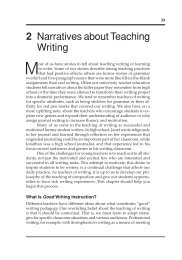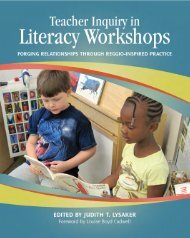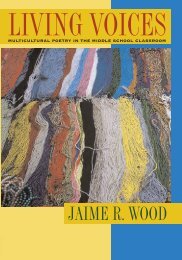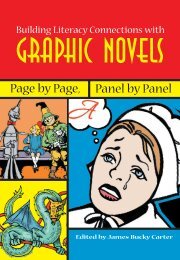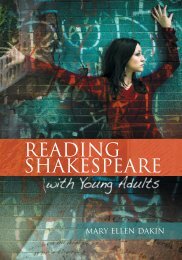Sample Chapter - National Council of Teachers of English
Sample Chapter - National Council of Teachers of English
Sample Chapter - National Council of Teachers of English
- No tags were found...
Create successful ePaper yourself
Turn your PDF publications into a flip-book with our unique Google optimized e-Paper software.
What Research REALLYSaysabout Teaching andLearning to ReadEdited byStephen B. Kucer
INTRODUCTIONCONTENTS9 Reaching and Teaching Thoughtful Literacy to ReadersWho Struggle: Instruction That Increases Motivationand Achievement . . . . . . . . . . . . . . . . . . . . . . . . . . . . . . . 198Michael L. ShawIII Where Do the Commission on Reading Documents Take Us?10 What We Know about Reading Curricula and BestPractices: The Decision-Making Matrix . . . . . . . . . . . . . 225Penny Silvers and Margaret Yatsevitch Phinney11 Pr<strong>of</strong>essional Development: Paradigms, Possibilitiesfor Change, and Praxis . . . . . . . . . . . . . . . . . . . . . . . . . . 250Brenda R. Hawkins12 Real Stories, Real Successes: Maintaining BestPractices While Coping with the Restrictions <strong>of</strong> NoChild Left Behind . . . . . . . . . . . . . . . . . . . . . . . . . . . . . . 272Laura RobbIV Appendixes: The Three Commission on Reading DocumentsAppendix A: On Reading, Learning to Read, and EffectiveReading Instruction: An Overview <strong>of</strong> What We Knowand How We Know It . . . . . . . . . . . . . . . . . . . . . . . . . . . . . . 295Appendix B: A Call to Action: What We Know aboutAdolescent Literacy and Ways to Support <strong>Teachers</strong> inMeeting Students’ Needs . . . . . . . . . . . . . . . . . . . . . . . . . . . . 308Appendix C: Features <strong>of</strong> Literacy Programs: A Decision-Making Matrix . . . . . . . . . . . . . . . . . . . . . . . . . . . . . . . . . . . 316INDEX . . . . . . . . . . . . . . . . . . . . . . . . . . . . . . . . . . . . . . . . . . . 327EDITOR . . . . . . . . . . . . . . . . . . . . . . . . . . . . . . . . . . . . . . . . . . 343CONTRIBUTORS . . . . . . . . . . . . . . . . . . . . . . . . . . . . . . . . . . . . . 345 vi
IntroductionINTRODUCTIONFrom the Beginning: Power for the TeacherYETTA M. GOODMANUniversity <strong>of</strong> ArizonaWhat Research Really Says about Teaching and Learning toRead reflects the focus among language and literacy scholarsconcerned with informing classroom teachers with knowledgeand research about the teaching <strong>of</strong> reading. The <strong>English</strong>language arts curriculum in school settings is now at a time inAmerican education where the power <strong>of</strong> the teacher is beingeroded by forces that place great trust in tests and statistical manipulationrather than in the power <strong>of</strong> a caring and thoughtfulpr<strong>of</strong>essional. Lack <strong>of</strong> respect for classroom teachers is not historicallyunusual in the United States, however; yet recent researchmakes it abundantly clear that the teacher in the classroomis most responsible for the academic achievement <strong>of</strong> the students(Darling-Hammond & Bransford, 2005). More than ever before,support for teachers is necessary to help them continue their development<strong>of</strong> pr<strong>of</strong>essional knowledge, and to expand on theirclassroom experiences to understand their role in the teachingand learning <strong>of</strong> language.The concern to inform <strong>English</strong> language arts pr<strong>of</strong>essionalslies in the origins <strong>of</strong> the <strong>National</strong> <strong>Council</strong> <strong>of</strong> <strong>Teachers</strong> <strong>of</strong> <strong>English</strong>(NCTE). Hook (1979) makes the case that NCTE began as agathering <strong>of</strong> “protesters against curricular rigidity imposed bycolleges on the American high school” (p. 3). Hook also makesthe case that the founders were organizers and builders. Thefounders, teachers, and teacher educators were responding to theimposition <strong>of</strong> mandates and tests on the <strong>English</strong> curriculum <strong>of</strong> vii
INTRODUCTIONAmerican high schools. Elementary school teachers also joinedthe protest that same year.The content <strong>of</strong> this volume expands on the mission <strong>of</strong> NCTEmembers to respond to uninformed impositions by those outside<strong>of</strong> the classroom, and to build an organization <strong>of</strong> teachers andteacher educators who would inform their pr<strong>of</strong>ession by providingbackground knowledge, theory, and research that can beadapted to their own settings. Through the authors in this book,members <strong>of</strong> the Commission on Reading, NCTE sustains its missionto support classroom teachers in continuing to develop theexpertise they need to be successful in developing curricula intheir classrooms that provide language-learning opportunities forall their students. The authors also provide guidelines and specificaids for classroom teachers to use as resources and referencesto develop a safe learning environment in which studentshave opportunities to use language, including reading and writing,as a tool for exploring the world.Since my own entry into teaching, I have been imbued withthe notion that curriculum is most effective for learners when theteacher is centrally involved in negotiating the curriculum withstudents. John Dewey (1938) makes clear that a curriculum embodiesall the experiences <strong>of</strong> the teacher and students as theycome together to learn.In the 1950s, as I was learning to become a teacher, we discussedideas and explored opportunities for teachers to developtheir own curricula in negotiation with their students. I valuedthe language-experience approach to the teaching <strong>of</strong> reading,which stressed building on children’s relevant and personallymeaningful experiences in and out <strong>of</strong> the classroom to write theirown reading materials and to expand on their learning. I usedadaptations <strong>of</strong> language experience with my self-contained eighthgraders, to engage them in writing a cantata based on the history<strong>of</strong> our new intermediate school in the city <strong>of</strong> Redondo Beach,California; and we published a literacy magazine based on theirwritings. We adapted Taba’s (1962) concepts about curriculuminquiry, and built habitats to compare the students’ immigrantcommunities to the communities in which their parents had grownup in Mexico, Japan, China, and European countries. There was viii
Introductionso much the students had to read and write in order to answertheir many, and <strong>of</strong>ten changing, questions about their world.When I went into teaching, I knew I would integrate speaking,listening, reading, and writing with my science and socialstudies programs. I knew that children enjoyed learning best whenthe experiences were interesting and relevant to their lives, andwhen they had choice in the materials they read and wrote. Iknew that classrooms could be organized in ways similar to social-groupwork settings, in which children could collaborate,solve problems, discuss, argue, and take leadership roles in organizingtheir classrooms with my expertise and help. My interactionswith students were based on trust that kids are alwayslearning, and on an understanding that the classroom communityin which we were learning together was <strong>of</strong> utmost importanceto our development as a community <strong>of</strong> teachers and learners.My students were capable <strong>of</strong> working in small groups and ontheir own, as I worked with them to provide safe spaces andopportunities in which they were learning to read and write whilethey were learning about their world. When I started teaching in1952, the term progressive education was rarely used. It was theMcCarthy period in American education, but the experiences thatmany <strong>of</strong> my colleagues and I were putting into practice in theclassrooms were rooted in the theories, philosophies, and concepts<strong>of</strong> progressive education, with the focus <strong>of</strong> using oral andwritten language as a tool to learn across the curriculum.My pr<strong>of</strong>essional involvement in language arts education inthe 1980s included my NCTE presidency (1979–1980) at thesame time that Dorothy Strickland was president <strong>of</strong> the InternationalReading Association (IRA). Charlotte Huck, who had beenpresident <strong>of</strong> NCTE four years earlier (1975–1976), proposed aseries <strong>of</strong> conferences for teachers and teacher educators to showcasethe research being done worldwide in reading, writing, andoral language that was especially relevant to elementary languagearts. Dr. Huck believed that if the knowledge were easily accessibleto teachers and teacher educators, it would have significantimpact on language arts curricula. Although Dr. Huck was notable to obtain funds to support the project, when DorothyStrickland and I became presidents, we enthusiastically picked ix
Introductionaction in reading. As elementary teachers expanded their use <strong>of</strong>trade books in classrooms, Rosenblatt’s concepts <strong>of</strong> efferent andaesthetic stances during reading helped them think about waysto engage their students in responding thoughtfully and personallyto literature. Nanci Atwell received the research award forher work on writing, helping teachers think about ways to engagemiddle school students in their own writing; and VivianPaley received the award for using talk and dramatic play withvery young children.Through the support <strong>of</strong> Rosemary Winklejohann, NCTE developedopportunities for individual and groups <strong>of</strong> teachers tobring their teacher-developed language arts programs to a panel<strong>of</strong> experts for suggestions and evaluation.The Commission on Reading added support for teachers’knowledge as they developed many projects, and advised NCTEin ways that supported the belief that teachers continuously developtheir teaching <strong>of</strong> reading as they build their knowledge andexperience to invigorate rich language environments and opportunitiesin their classrooms. Much <strong>of</strong> the focus <strong>of</strong> the work <strong>of</strong> theCommission is to assure that teacher-developed language artsprograms are at the heart <strong>of</strong> teachers’ work. Pamphlets, checklists,and commercial reading and language arts programs arehelpful to teachers, but only if teachers use such materials astools to inform their own decisions about curriculum development.The teacher is the decision maker in the classroom.What Research Really Says about Teaching and Learning toRead emerged from deliberations by recent members <strong>of</strong> the Commissionon Reading, who believe that teachers are decision makersabout their curricula. The matrixes and documents developedby the Commission were written to highlight the knowledge aboutthe teaching and learning <strong>of</strong> reading that would support teachersin organizing their classroom environment. The documents weredeveloped over a period <strong>of</strong> time so they could be presented toteachers, teacher educators, and reading researchers for reflectionand response. In this way, the documents were put into practicebased on the experience and knowledge <strong>of</strong> a range <strong>of</strong>pr<strong>of</strong>essionals in the field. The importance <strong>of</strong> the documents isthat they are meant to guide and engage teachers to considertheir own knowledge about their students and their own beliefs xi



